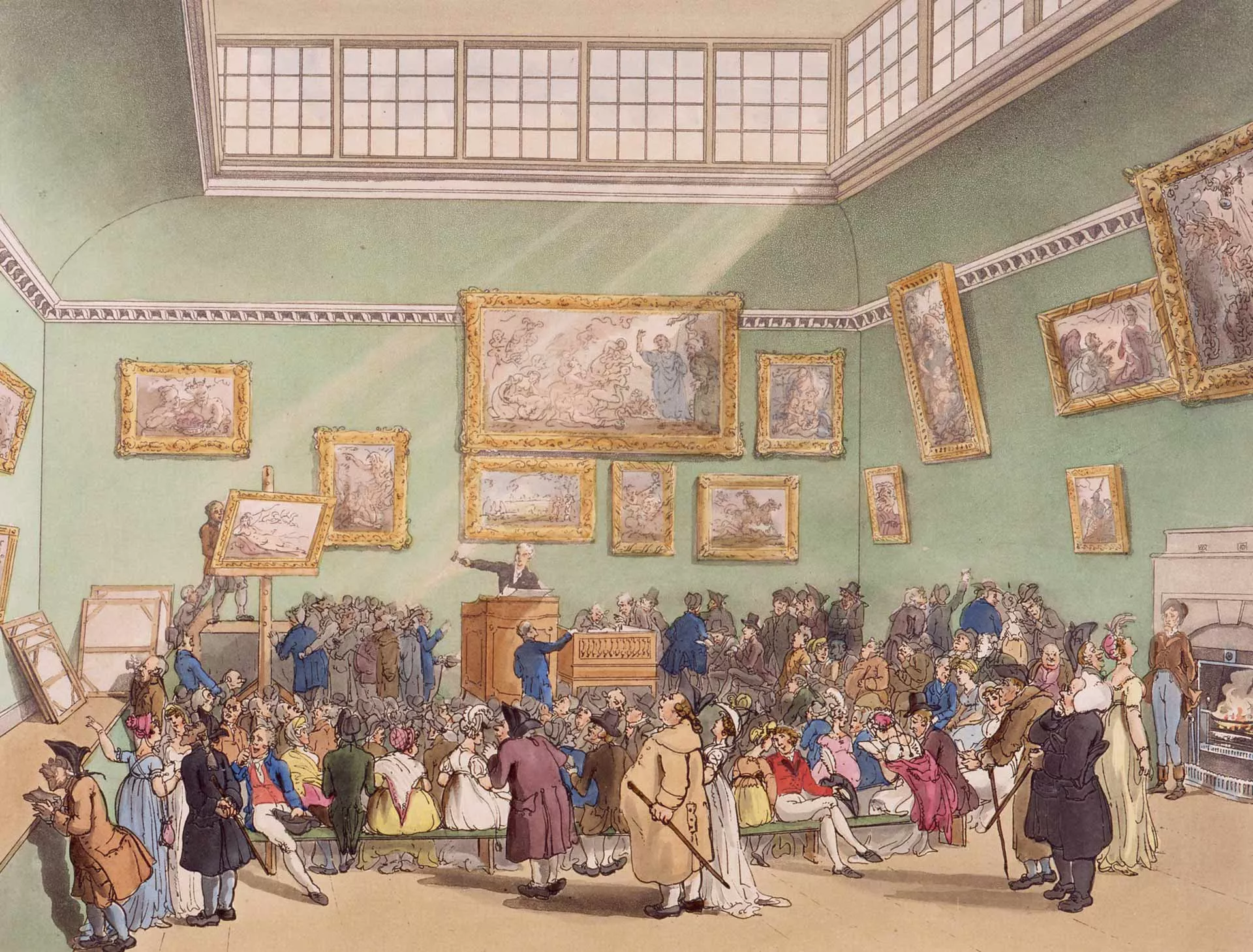Creation Date
1808
Height
10 cm
Width
12 cm
Medium
Genre
Description
This image depicts an art exhibition and sale at Christie's, London's famous auction house, drawing attention not only to the displayed artwork but also to the busy social scene.
In a large green exhibition hall, a crowd gathers to attend the auction. Men and women sit on benches in the middle of the room: most face the auctioneer standing in the rostrum, though some converse and others read the catalogue. Male viewers also surround both sides of the podium; to the left, a man hangs a Venus painting on a pole mount, and on the right, a man sitting at a raised desk helps dealers with art purchases. Paintings of history scenes and landscapes hang scattered along the sides of the hall, and several large canvasses lean in the back left corner. People are standing and milling around the benches, looking at the paintings on the wall; on the right, a man stands alone in front of the fireplace.
As the premier art auction house in the nineteenth century, Christie’s was the site for viewing and acquiring art as well as an important social scene. The auction house was an important alternative to other, less accessible art venues, such as private galleries and emergent museums, and, as a result, many viewed auction houses as institutions of taste that enabled people to become enlightened collectors:
It is to be hoped that a general knowledge and taste for the arts are now so far diffused among us, that the nobility and gentry are awake to living merit, and can properly appreciate those powers by which the old masters have acquired their high reputation. (Pyne 36)
The auction house made art available to the public as both spectacle and possession, bringing art home to the English public literally and metaphorically. Like other public sites of art such as the Great Exhibition and the theater, by 1733 Christie’s was perceived as as popular entertainment. People from a range of social classes came to the picture sales to view art as well as to see and be seen by society (Hermann 29). Thomas Rowlandson’s depiction of an art sale at Christie’s deftly illustrates this blurring of spectacle and spectator as well as the variety of viewing practices: men and women not only come and go, looking at paintings, but also sit watching and conversing with each other.
Locations Description
Founded in 1766, the auction house first operated on Christie’s premises, then in the Pall Mall Room (which had been vacated by the Royal Academy), and finally moved in 1823 to 8 King’s Street in St. James’s Square, where its headquarters are still found today. Christie’s was the premier auction house, unrivaled by the older Southeby’s (founded in 1744 by Samuel Barker), which specialized in literary property and libraries and did not extend to art auctions till the mid-nineteenth century (Hermann 29).
Publisher
Rudolph Ackermann
Collection
Accession Number
5212 (4°) vol. 1
Additional Information
Bibliography
Herrmann, Frank. The English as Collectors: A Documentary Sourcebook. New Castle: Oak Knoll, 1999. Print.
Grego, Joseph. Rowlandson the Caricaturist: A Selection from His Words, with Anecdotal Descriptions of his Famous Caricatures and a Sketch of his Life, Times, and Contemporaries. London, 1880. Print.
Hayes, John. “Rowlandson, Thomas (1757-1827).” Oxford Dictionary of National Biography. Ed. H. C. G. Matthew and Brian Harrison. Oxford: OUP, 2004. Web. 2 July 2013.
Pyne, W.H. and William Combe. The Microcosm of London; or, London in Miniature. 3 vols. London: Ackermann, 1904. Print.

